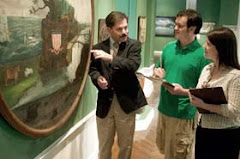I've seen cathedrals and temples large and small over the years, but the Faith Mission is the one of the most memorable churches I've ever been in. It wasn't hard to find; in a non-descript neighborhood in Newport News, Virginia, the small domestic structure that held the church stood out by virtue of the large painted images of Jesus and assorted angels surrounded by quotes from scripture all over the exterior facing the street.
Not even the jubilant facade, howver, could prepare you for what was inside.
Anderson Johnson was born in Virigina in 1915, the son of a sharecropper. One day, when he was eight years old, he was hoeing a field when he had a vision of God holding out a large, leather-bound book to him. He took that as a sign that he had been called to preach. And preach he did for much of his adult life, using his spiritual fervor and musical talent (specifically his steel guitar) to bring people to Jesus.
Johnson moved back to Newport News in the 1970s to live with his mother, and after her death in 1984 he finally had the chance to create his own church. And so, in that same house, the Faith Mission was born. It was at this time that Johnson put another of his talents into service to Jesus by creating visionary works of art.
It wasn't hard to decipher Johnson's vision. When I visited him in the early 1990s I was initially astonished by the painted facade of the Mission. When I went inside, however, I was completely bowled over. The whole first floor of the house had been gutted to make one large space, with makeshift pews on the front side and an altar and lectern on the back. But that wasn't all. Not by a longshot.
The makeshift church was full of people; bright-eyed, well-dressed, and eager for the Bishop Anderson Johnson's sermon. But they weren't actual people. They were painted portraits by Johnson, smiling, attentive visages on cardboard or plywood, lining each and every pew and even hanging from the rafters. An audience of every speaker's dreams. And a congregation worthy of Johnson's abilities.
Reverend Johnson himself was a delight to meet and converse with. He was not a fundamentalist nutcase. He was friendly and soft-spoken and humbled by his calling. I asked how many parishioners he had. "I've got five that I can count on." That didn't keep him from his committment to preach. We ended up buying several pieces for the
Fenimore Art Museum, including a lectern (above) and a painting of an angel (below).
The only time that I saw him upset was on another visit a year or two later. Reverend Johnson had been having some problems with his neighbors. Since he had become well-known as a folk artist, scores of people - strangers to the neighborhood - were coming to see the Faith Mission and buy art. The neighbors accused him of drug dealing. As he explained the situation to me, he got angry, ripped open a decorative container he had made to show me there was nothing inside, and yelled "I don't know nothing about no dope dealer!" It was extremely upsetting to see this good man have to defend himself.
But the memory reminds me, as I think of Reverend Johnson's beautiful people, how wide is the gulf between the world as it is and as it ought to be. Anderson Johnson did what he could to narrow that divide, in a small corner of the world that desparately needed his presence.
- Posted using BlogPress from my iPad

































































